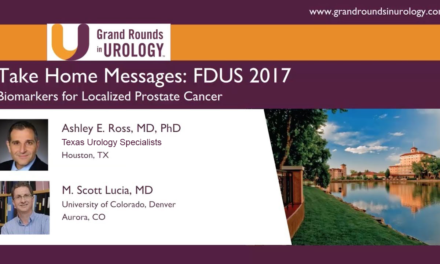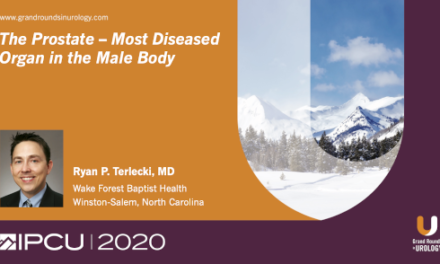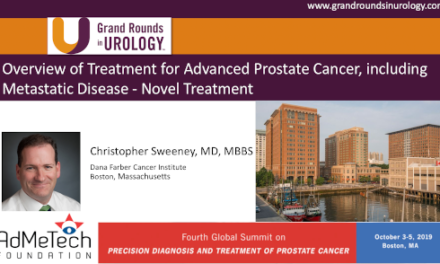This is presentation three of five of the CME accredited program, “The Multidisciplinary Approach to Treating Prostate Cancer Using Radiopharmaceuticals.” Please complete all lectures before clicking on “CME Post-Test.”
Keywords: prostate cancer, radium-223, docetaxel, abiraterone, cabazitaxel, enzalutamide
How to cite: Petrylak, Daniel P. “Update on Clinical Trials and New Targets.” Grand Rounds in Urology. September 13, 2016. Accessed Jan 2025. https://dev.grandroundsinurology.com/prostate-cancer-daniel-petrylak-update-on-clinical-trials-and-new-targets/.
CME POST-TEST
Thank you for participating in the CME activity.
For CME credit, visit Medical College of Wisconsin. Immediately upon passing the online test, you will receive your certificate via email.
Transcript
Update on Clinical Trials and New Targets
So change the topic of this a little bit because unfortunately are not going to be many trials maturing in the next year, that I think are really important. What I’d like to focus on in two different areas is update on the trials as well as some new targets that we’re going to be reviewing. Raoul mentioned before that AR-V7 is an important player in this disease and there are other treatments that are being developed against AR-V7 tumors. And he mentioned the Tokai drug, galeterone, which is AR degrader as well as CYP17 inhibitor. There are also bromodomain inhibitors as well, they’re not going to clinical trials. We know that Gilead has got one in particular that we’re working with at Yale, and they’re also N-terminal inhibitors of the androgen receptors as well. So what happened with the Tokai trial. This was a randomized study, galeterone versus enzalutamide and these were in patients who are AR-V7 positive. Now this trial shut, due to the futility analysis after only 110 patients were entered in this particular study. The big problem with this trial was finding patients who are AR-V7 positive, number 1, at least in our experience, and the other problem was these patients had to be asymptomatic or minimally symptomatic, so somebody who’s very, very symptomatic could not really go on this particular trial if they were on pain medication, so they restricted their population very, very greatly. And this made for problem trial approval and it was decide to shut it early because of that particular reason, so this is not going to be moving forward. This is another trial that is also in refractory patients that was reported in the press although it’s supposed to be reported at ESMO this year. It’s s randomized trial of cabazitaxel plus custirsen, which is anti-HSB27, anti-sense, combined with prednisone compared to cabazitaxel and prednisone alone. This particular compound was originally evaluated with docetaxel as frontline therapy, for metastatic castration resistant prostate cancer. It also was a negative trial but what they did was they did a subanalysis and found that those patients who had poor prognostic factors, liver metastases, HIOP [phonetic] and phosphatase ILDH. These patients actually benefited by receiving the anti-sense. So they actually modified their endpoints and still did not see a survival benefit in terms of poor prognosis. So a combination therapy with cabazitaxel was not going forward. This trial I thought was very, very interesting, but this trial was also shut due to the lack of accrual. This is taking patients who had failed abiraterone or enzalutamide within six months, looking at different biological markers and randomizing to receive cabazitaxel or abiraterone. If they’ve had enzalutamide previously or enzalutamide if they’ve had abiraterone. The trial unfortunately only accrued about 10 patients nationally and is now shut. I think this was one of the more interesting biological questions because of the fact that the AR-V7 mutants were being looked at, and we always have the questions to whether we should go onto more chemotherapy or try hormones. Now what about the timing and sequencing of chemotherapy? The TROPIC trial as we know proved cabazitaxel as second line therapy, from metastatic castration resistant prostate cancer. And to remind you it’s about a three month difference in the overall survival so the real question is, is there actually an advantage to moving cabazitaxel upfront in comparing this to docetaxel. Unfortunately these slides didn’t translate properly but it was a three arm study with 1,100 patients comparing cabazitaxel 25 mg or docetaxel as frontline chemotherapy. And you could not see a better superimposition of survival curves. There was no difference in survival between any of these particular arms, so docetaxel is still considered the frontline treatment of choice for chemotherapy except in the situation, when you start looking at subgroup analyses from toxicity, except in the situation where there maybe peripheral neuropathy, and I think that’s a justification for moving cabazitaxel upfront. Better responses by RECIST but again this was when you compared the docetaxel, 25 mg cabazitaxel, you didn’t see a difference with the 20. And as I mentioned before different toxicity patterns. This is also something you’ve got to look out for with somebody who’s on cabazitaxel, it’s actually more hematuria, and there may be some – – develop cabazitaxel over time. It does not demonstrate superiority of 20 or 25, versus docetaxel. There is no difference in PFS, response rate were similar. They did seem to be a higher response rate for 25 cabazitaxel but again that does not translate to a survival difference. What about second line, 20 mg versus 25 mg of cabazitaxel. This is the PROSELICA trial, often with an elderly patient you really don’t want to give high doses of chemotherapy, or if they’re frail, and there’s considerable questions as to whether you should give a higher dose of cabazitaxel. This trial showed there was no difference so 20 actually is an acceptable treatment to give if you need to give lower doses. However, the interesting subgroup analysis was found that those patients who had prior abiraterone, enzalutamide or prior abiraterone actually favor cabazitaxel 25 mg. So this is again somebody you may want to consider putting into your treatment algorithm. Febrile neutropenia as one would expect was higher, hematuria was higher, I the higher dose of cabazitaxel. So those I think are the important trials from ASCO that were presented. They are practice affecting where we’re moving in the future. So this was actually something was overlooked from the TCGA. This was published in 2012 from Nature, looking at aberrations in DNA repair genes. So about 50% of the cases of castration resistant prostate cancer were examined. There were examined by this particular technique, were found to have aberrations in DNA repair. And we know that PARP or poly-ADP-ribose polymerase helps to repair DNA, particularly double strand and breaks. And as we know, those that are not repaired will go on to die and apoptose. So inhibition of PARP in patients who have abnormalities of DNA repair, is a therapeutic target. So the TOPARP study which was published by Dr. DeBono Mateo was the first author, looked at 49 patients with metastatic castrate resistance prostate cancer who had previously received docetaxel. And when you looked at all patients, unselected patients, the response rate was 32.7%, 16/49. Post hoc they looked at aberrations of the DNA repair pathways, this included ATM, BRCA, and of those 33% had mutations. Sixty-seven percent of course had no biomarker mutations, 14 of those 16 patients responded to a PARP inhibitor. So that’s actually pretty impressive and an impressive way of selecting out these different treatments. Of those patients who had no mutations, two of those particular patients responded. So DNA repair is a theme that we’re moving forward with and we know this from radium-223 and I would actually wonder whether a biomarker study needs to be done looking at bone specimens of those patients treated with Radium to see if those are the patients that we see the PSA declines in. That 25% to 50% that have BRCA or other DNA repair mutations because we know that Radium does cause damage to the DNA repair mechanism. So to refresh your memory, this was the original ALSYMPCA trial that randomized patients to radium or placebo. Both docetaxel refractory as well as those patients who refused docetaxel, and we know we had about a 3.6 month overall survival benefit. We see what we would expect a higher difference or a greater difference in survival, for those who are prechemotherapy, versus those who are postchemotherapy. But we’ve seen this data an awful lot, so what are some of the things that we’re learning about Radium-233? Well, we know it improves survival, we know that it also affects the rates of skeletal events, and that you can give concomitant therapies such as external beam radiation therapy and bisphosphonates. But also I think this is where we’re going to have to focus on this therapeutic layer in the future looking at other hormonal agents because this trial did permit bicalutamide, dexamethasone, DES, or other hormonal agents. But we’ve really not generated any data with abiraterone or enzalutamide, denosumab and no good imaging studies have looked at this. So also Radium’s – -to six cycles and we’ve got a lot to learn from that particular issue. So I think one issue again on the DNA repair pathway question is, can we give more than six cycles of Radium, and there’s a study that’s looking at this particular question. For those patients who have nor progressed on radium, they were eligible to receive six more cycles after progression. This was given safely without any for the hematologic toxicity. Now the interesting thing is that the progression curves in bone, very, very low levels of progression in bone as evidenced by this particular Kaplan-Meier curve. The progression predominantly wasn’t soft tissue. Soft tissue dominant. This again is going toward the fact that we need to layer our therapies along with other hormonal agents. There also can be more of an intense osteoblastic reaction if you’re giving bisphosphonates along with radium, and again this would apply there’s some synergy although we really didn’t see that from the ALSYMPCA data. There was no combined effect on survival, but we do see an effect on the skeletal-related events if you give the two of them together. Denosumuab does also from the extended access program, again of course these are select patients, but it does seem to be a survival benefit by giving denosumab plus radium versus those patients who received radium alone. And again, this is leading towards the fact that they want to continuing denosumab in this group of patients. Now I think this is the most fascinating curve from the EAP data and this is basically showing is that there’s actually improved survival if you give abiraterone along with radium-233. And this is actually something I’ve got in my practice for those patients who were chemotherapy naive starting them on abi, they may have a lot of bone disease, I’m trying if I can do by insurance to give both of them at the same time. Now also I didn’t mention too that we’ve just completed accrual in a randomized trial competing radium plus abiraterone versus radium plus enzalutamide and then comparing that to radium alone. We’re looking at time to progression as well as skeletal-related events as well as radiographic events. That trial shut about six months ago. It should be mature by Christmas time, and I hope that we’ll have that data ready for big ASCO. There’s also a randomized trial that Matt Smith [phonetic] is running, of abi, plus radium versus radium alone. So finally to end this up looking at different the amount of doses of radium. I think it’s important to note that we should try to give these patients full treatment. We treat them through. And the only justification I could see for stopping radium treatment early would of course be toxicity or the fact that they developed visceral metastases on treatment. And this is a curve that Oliver presented at ASCO last year looking five to six injections of radium versus one to four injections, and there is a difference in survival. But you also see the same difference when you look at placebo. The placebo patients, they actually do better if they receive more placebo versus not. So how do you explain this? Well, this may be related to patient selection but again I think again it’s important for all of us to give radium as much as we can. Also again, looking for number of injections, overall survival seems to be better – – with higher numbers of injections. So some of the covariates of predicted number of injections, these go along with overall volumes of disease. this includes hemoglobin, Log LDH which may actually be related to the visceral metastases and then Log of PSA. So in conclusion, isotope therapy demonstrates promising results when combined with second generation hormonal agents. AR-V7 is for selectively–against enzalutamide versus abiraterone, but unfortunately the trial that was trying to assess that is negative. And I think this is the most exciting area right now in clinical trial in prostate cancer, there are at least three different randomized studies that I can think of that are opening up. There’s AstraZeneca of course, olaparib, there’s a compound that’s coming from Janssen, there is a third PARP inhibitor from an independent company. So this is where everybody’s running to in the therapeutic milieu in prostate cancer. So I’ll stop there and turn the podium back to Dr. Concepcion.
ABOUT THE AUTHOR
Daniel P. Petrylak, MD, is currently Director of Genitourinary Oncology, Professor of Medicine and Urology, Co-Leader of Cancer Signaling Networks, and Co-Director of the Signal Transduction Program at Yale University Cancer Center in New Haven, Connecticut. He is a recognized international leader in the urology field. He earned his MD at Case Western Reserve University School of Medicine in Cleveland Ohio. He then went on to complete his Internal Medicine Residency at Albert Einstein College of Medicine/Jacobi Medical Center in the Bronx, and his fellowship at Memorial Sloan Kettering Cancer Center in New York.
Dr. Petrylak has served as principal investigator (PI) or co-PI on several SWOG clinical trials for genitourinary cancers. Most notably, he served as the PI for a randomized trial that led to the FDA approval of docetaxel in hormone refractory prostate cancer. He also helped to design and served as PI for the SPARC trial, an international registration trial evaluating satraplatin as a second-line therapy for hormone refractory prostate cancer.
Dr. Petrylak served on the program committees for the annual meetings of the American Urological Association from 2003-2011, and for the American Society of Clinical Oncology from 1995-1997 and 2001-2003. He also has served as a committee member for the Devices and Immunologicals section of the FDA. He has published extensively in the New England Journal of Medicine, Journal of Clinical Oncology, Journal of the National Cancer Institute, Cancer Research, and Clinical Cancer Research.





